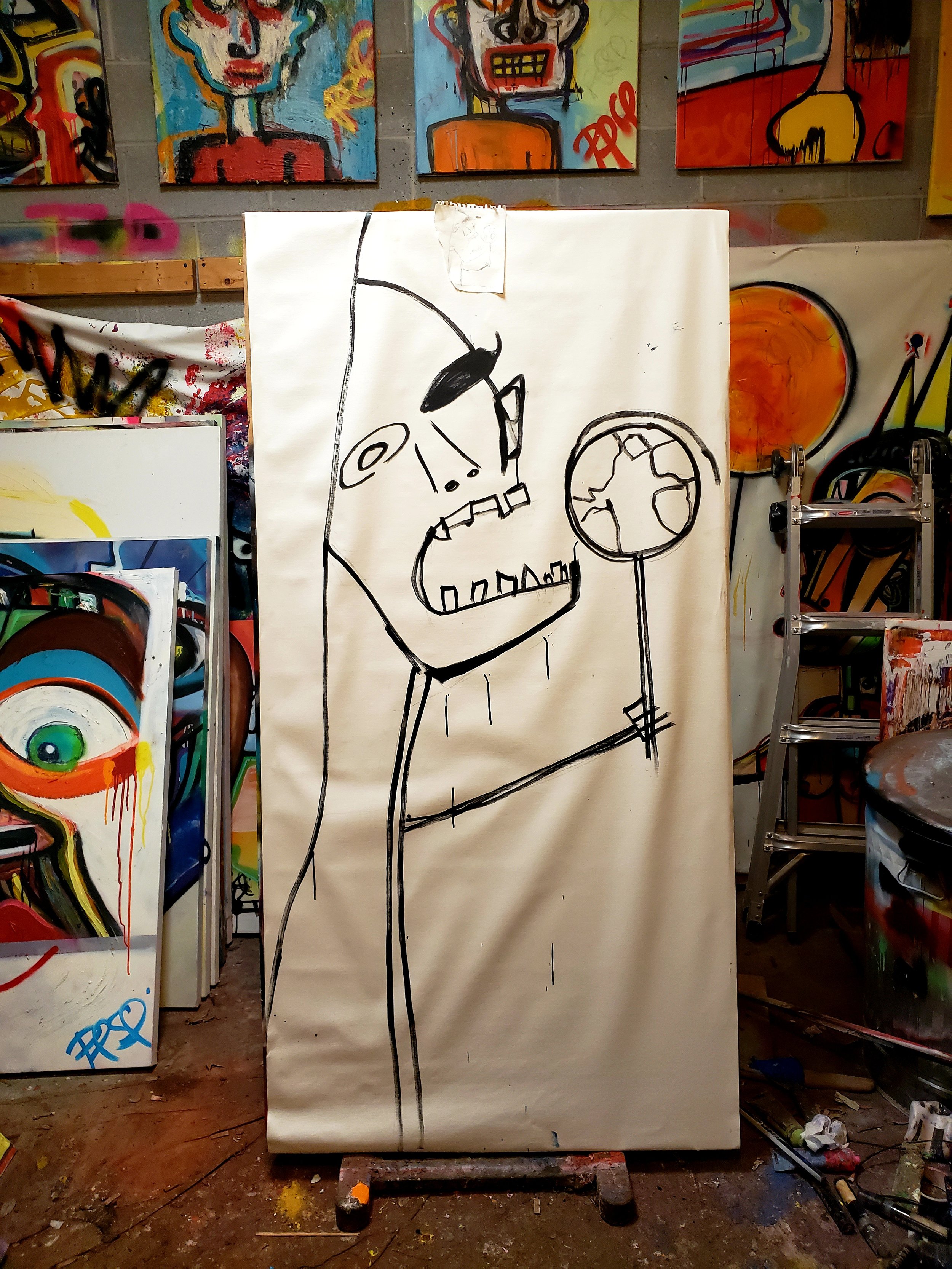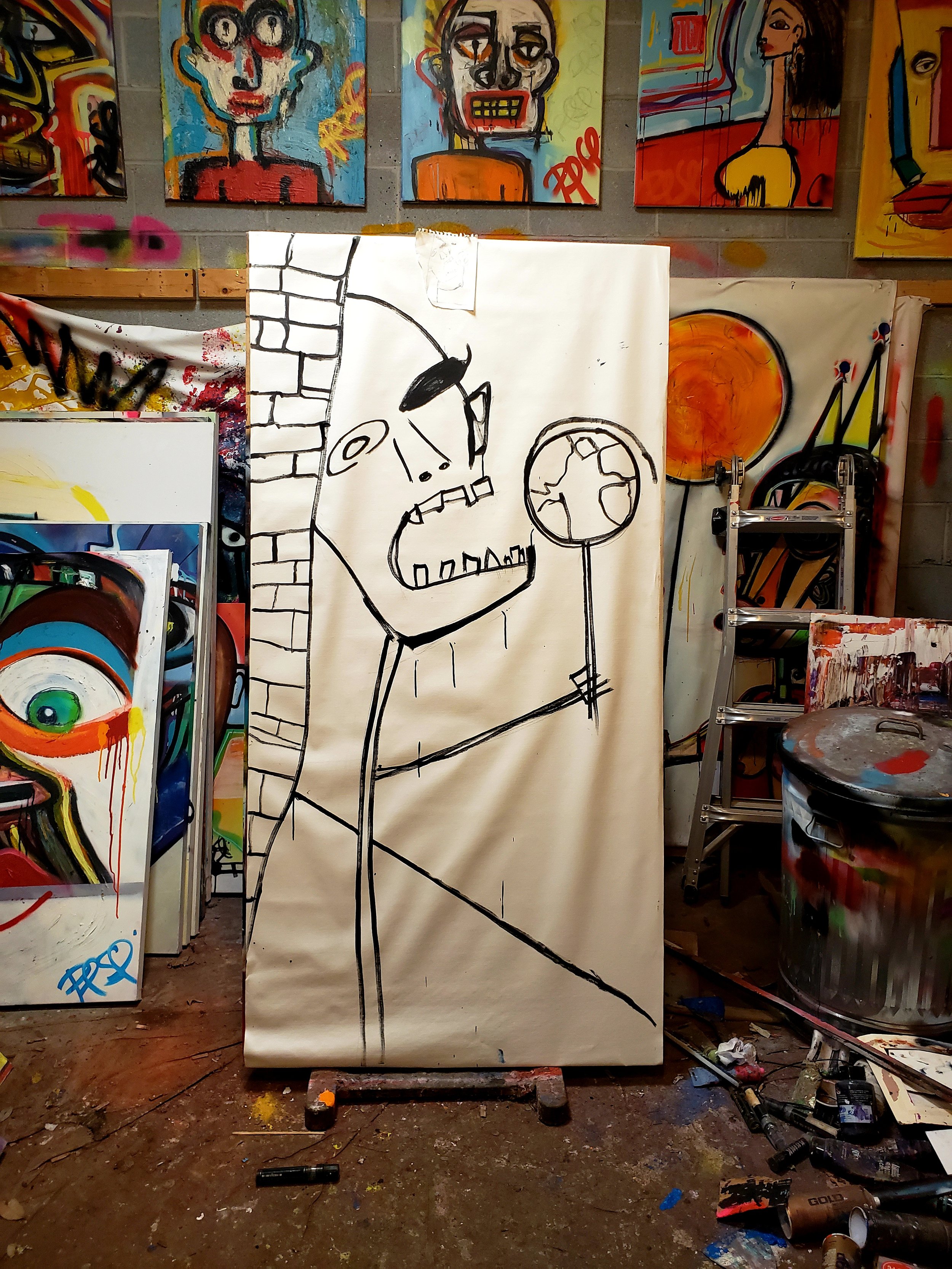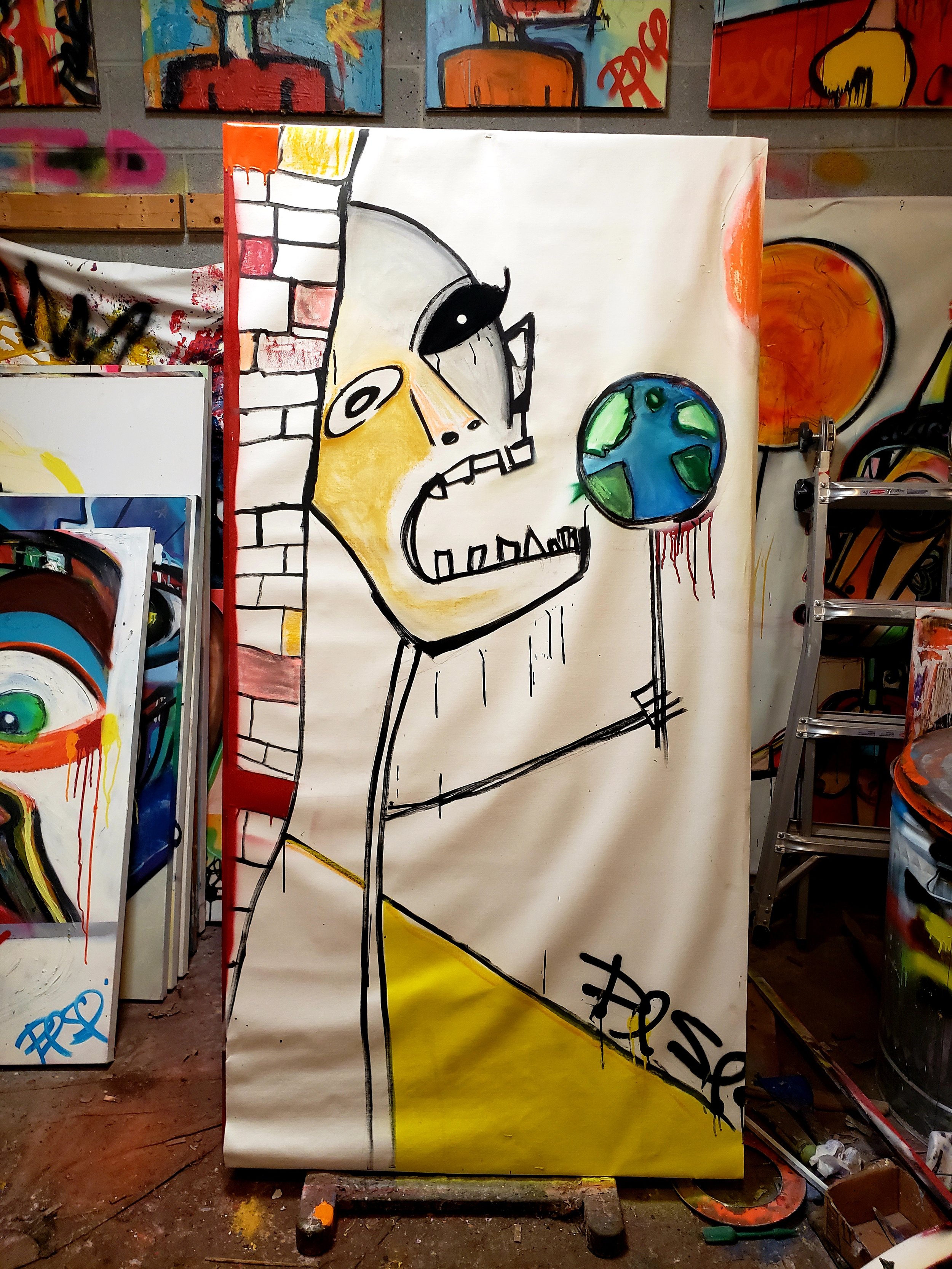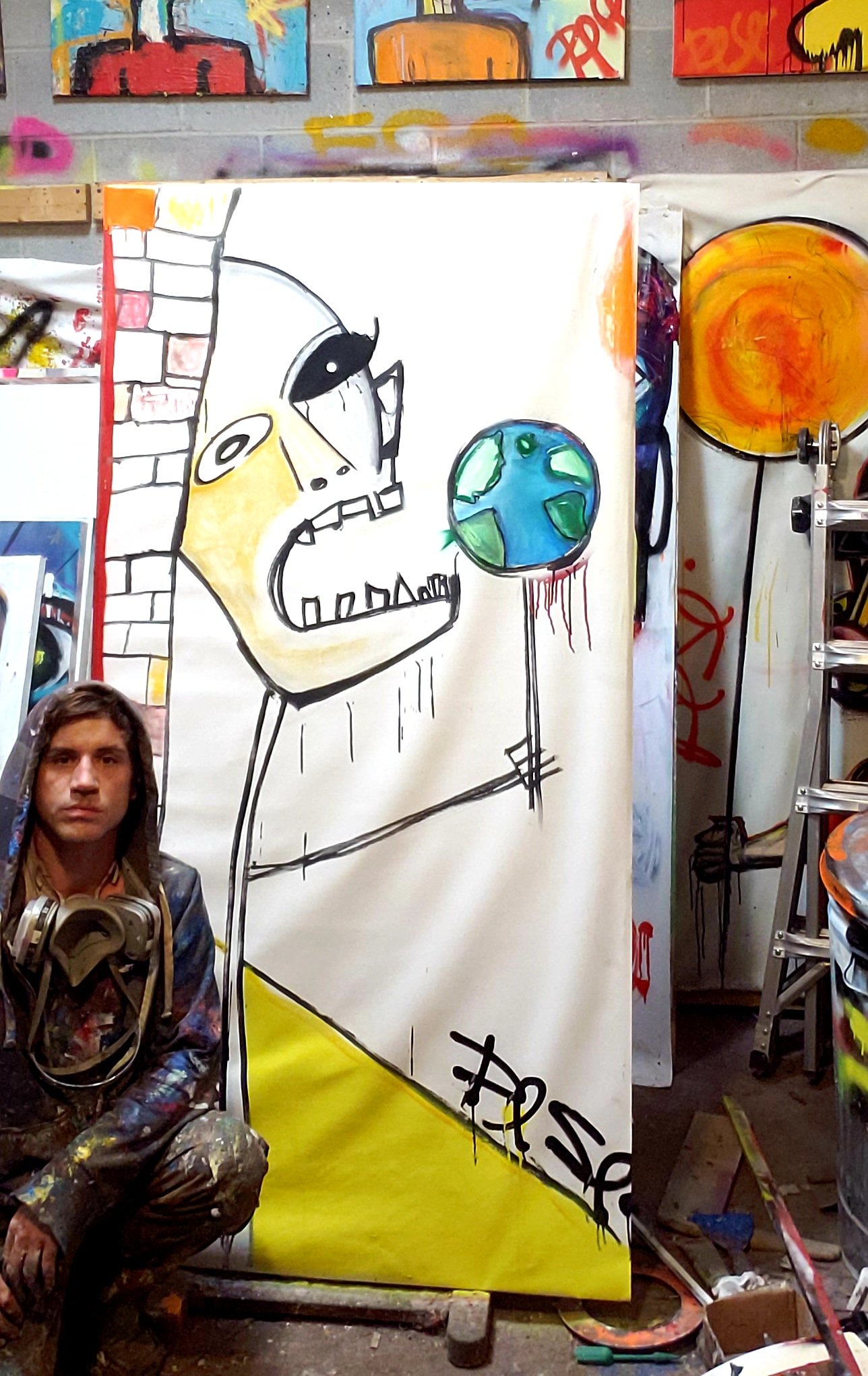To Her We Do Belong
Paul Seli
“I tried to work with what I’ve got and not totally lose my own artistic viewpoint.”
Interview by C. VanWinkle
October 21, 2022
Can you describe what it was that you responded to?
It was a poem, a great poem. I don’t remember how many lines it was. It seemed to be a mix of positive and negative. The negative aspect is “We’re fucking up the earth pretty well,” and the positive aspect is “Let's change that in some way.” Let's focus on how to improve the quality of living and the earth, respecting it more. At first, I started to paint an earth and I was trying to literally put maggots or other things from the poem into the painting. I added a tree coming up from the debris to signify the hope of humanity realizing what we’re doing and changing. But then I just stopped. It just wasn’t me. The point is to do my art, filtered through something else. It doesn't have to be verbatim, and I think it's more fun if it's not just a broken telephone of art. Instead, I made a dude who's eating a bleeding lollipop Earth, because he doesn't seem to give a fuck about its well-being.
Who is the dude?
Oh, I don't know. No one in particular. Just an archetype of humans in general. Certainly not me. I have a car, but I try to minimize driving it around. I pretty much just drive it to get groceries and paint supplies. And if it's warm enough, I can take a bike that has saddlebags. I bike basically everywhere because I actually give a shit about the planet. You know, carbon emissions and greenhouse gases and whatnot. So it's just an archetype of the average human who doesn't really consider the cost to the planet.
We eat it without feeling bad.
Exactly. I scraped the paint off from that first attempt and now I've got a canvas that I'll use for something else. I put it aside and then I pulled out this canvas and started anew. Lately I've been doing faces or people. That's what I really quite enjoy now. I decided to stay true to my art rather than totally changing my style. I definitely hate commissioned pieces because I feel so constrained by what I'm doing. I initially started by putting that constraint on myself, but then I thought, fuck it. I'm not going to do that anymore. Blank canvas. Let's start anew, in my style. I typically don’t do this with paintings but I might start doing it more: I ripped off a little piece of paper and did a super quick sketch, just a dirty, rough sketch of what I had in mind. Then I stapled it to the top of the canvas I was working on so I could use it as a reference point essentially. Then I drew it with paint and colored it in based on intuition. That was the general process.
How big is it?
It’s 3 feet by 6 feet.
Wow, I think of that as huge. Do you usually work so big?
Yeah, typically. I've done smaller pieces than this, but I don't tend to work smaller than 3 by 4 feet. For me, the bigger the better. Generally, 3 by 4 feet, 4 by 5, that sort of thing is what I work with.
One of the lines of research at Duke that I'm doing as a psych prof is looking at how we might be able to essentially hack sleep states to get creative ideas. Hypnagogia is the term for the transition between wakefulness and sleep. We go through it every time we fall asleep at night or take a nap. Salvador Dali, Thomas Edison, Nikola Tesla, Edgar Allan Poe, a bunch of really famous inventors, artists, and whatnot would hack this state so that they would get cool ideas. I've got a device that helps people to tap into hypnagogia and get this creative experience. I’ve validated these anecdotal reports from these people. People tend to be more creative in these cases. Also, I frequently lucid dream, and this is where I find the greatest utility. I can control my dreams. Not always, but if I set an intention to do so, I'm pretty good at doing it. I'll close my eyes and imagine myself in an art gallery with my own pieces. Then I'll open my eyes and I'm there in my own gallery with paintings that I haven’t actually done yet. They’re just a representation of my thoughts. In those lucid dreams, the paintings are like 30 by 50 feet. They're all fucking massive! I love big canvases for some reason. I've always just been a fan.
I work much smaller than you do, but I keep slowly getting the nerve to go bigger. Maybe someday I'll make something big enough to be measured in feet, but I'm still in my baby steps.
In 2015, when I was in Boston, I didn’t have a convenient set-up for the kind of art I do because I get fucking messy. I get paint all over the place. So I’d go up to the rooftop of my apartment building, set down a drop sheet, bring the easel, bring all the paints and stuff. It was such a process just setting up and tearing down. There’s psych research on this. For example, if you want to learn guitar, get a guitar stand in your fucking living room where it's there. It's ready. You don't have to put in extra effort. Same with going to the gym. The closer the gym is to you, the more likely you are to fucking go. You minimize the costs associated with doing things.
Anyway, I was in Boston doing that, and I remember I bought my first big canvas. It was 3 by 4 feet, or 36 by 48 inches, and it cost like, I don't know, 75 or 100 bucks. That's fucking terrifying, man! Holy shit, what if I fuck it up? But then, as I've learned since then, and I know this is cliché, for me it’s more about the journey than the destination. In fact, the destination turns out to be better when you focus on the journey instead. I just want to have fucking fun with it. And you know what? I've had paintings that are massive, costing like 200 bucks for the canvas, and I just scrape the paint off. Or I just leave it and let it dry, and then that's a backdrop for what I'll paint over it. Now I've got this depth. I’m essentially endorsing the view that there’s no wrong way to do it. That’s been the best way for me.
That's great. I learned recently that if I have pieces that I don't like, I can repurpose them, just as raw material, to make something different. It’s been a gamechanger. Not only can I make something I like, but even out of something I didn’t like.
Totally! I've got some paintings like the one hanging over there. It’s 30 by 30 inches and the thing must weigh like 50 fucking pounds because there are 50 paintings or whatever underneath it. Oil paint is thick! I lay it on thick and I just kept going until I was finally happy with it, and now it's got this beautiful texture. All of the previous sessions are part of it, you know? They're providing texture and background for it.
Although I've been focusing far more on painting these days, I’m a musician as well. There are songs that I recorded 20 years ago that I wasn't satisfied with at the time. I wasn't happy. And I listen to them now and think, “Holy shit, that's pretty cool!” Throughout our lives, we're changing our perceptions, our appraisals, our preferences. Sometimes you have fresh eyes or ears to look at or listen to something you produced many years ago. You lose that inner critic and, in some cases, you realize it was actually quite cool. You know, I'm glad I didn't paint over it or record over that tape or whatever.
How does this piece relate to the rest of your work?
I've been doing creepy dudes, or humans, for the most part. I'm so naive when it comes to art history. I've never taken a class in it or learned how to actually, physically paint or draw. I've never taken any classes, but I've always been somewhat obsessed with it. I learned about Basquiat’s work early in Covid times. Prior to that, I was just doing strictly abstract pieces with no figurative element or identifiable thing in the painting. Just blending a bunch of colors. Then I started to shift a bit more toward figurative stuff. I’d do like cityscapes sometimes. Trees were pretty prominent. Then, when I learned about Basquiat, I was like “Holy shit!” And I always loved Picasso's work too. Those are my two heroes, I guess. And then it feels like a holy trinity, where I'm adding my component to their work. I’m certainly influenced by them, but I’m also doing a different thing, very much standing on their shoulders. That's where I've been at lately.
To put it more simply, I've been doing creepy, humanoid figures, and since that's my current style, I might as well go with that. I tried to work with what I've got and not totally lose my own artistic viewpoint.
In this project, there isn't really a wrong way to handle that. You can stay close to the prompt or you can go off in a different direction. It's interesting to see how different people feel out their own balance there.
I think it's such a cool idea. I don't know what came before the poem, but I'm fucking fascinated by figuring out the lineage and how much it's evolved over the different iterations, with different mediums and different people. It’s a really cool project.
Thanks! It’ll all be revealed when the issue comes out. You seem like you work really fast. Are you good with deadlines?
Well yeah, I’m super conscientious, like 98th percentile or something. Most of the time, there is no deadline when I paint. I'll do it every night or every other night, but it's not because I have to and I prefer to keep it that way. This is partially why I'm not a huge fan of commissioned pieces. They're constraining in certain ways, not just in terms of time. I have not been diagnosed, but I'm probably like high-functioning autistic, and as a psychologist I think I can quite reasonably say that. One beautiful consequence of that is that I get obsessed with stuff. I can paint for 10 or 12 hours straight and love it and get into a flow state and listen to music and dance while I'm painting. It's like therapy for me, essentially. Consequently, I’m good with deadlines, but that's not the purpose. I'm not intentionally trying to be good about deadlines. I just usually finish a piece in one or two sittings, like 8 to 12 hours each. So as long as I have the creative freedom to do whatever I want, it's fun. In this case, there was a thread to follow. I didn’t want to do something totally random as if I had not read the poem, but I'm glad that I had the prompt. Who knows what I would have painted that night instead of this thing?
Now that you have done this once, what is your advice for a first-timer coming to this project?
The same advice that I gave myself. Imagine you are a kid and there's a canvas in front of you and paints. Rarely does that child say, “Oh, I'm so worried about what the final product is going to be. I'm so worried about how I'm going to judge it. I'm so worried about how other people are going to judge it.” Get rid of that and just play. That's key. At first, I took it too literally. Keep your own spirit alive, your own viewpoint or creative contribution, by keeping it in the vein of your artwork, yet still maintaining the thread in some way. Be flexible, don't put pressure on yourself, and maintain your true artistic sense while you're doing it.
Call Number: C82PP | C83VA.seTo
North-Carolina-based artist, Paul Seli, has been honing his skills in abstract and neo-expressionist art since 2002, and has more recently delved into digital art, artificial intelligence, and NFTs. Currently a Professor of Psychology and Neuroscience at Duke University (https://www.mindatlargelab.com/), and formerly a Banting Post-doctoral Researcher at Harvard University, Paul investigates consciousness in its various forms, with a particular focus on creativity and altered states of reality. In his studio, Paul blends his knowledge of the human mind with his passion for artistic creation, bringing about a symbiosis of his two passions.








